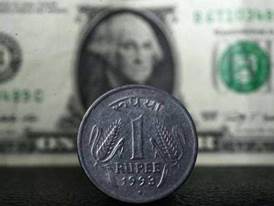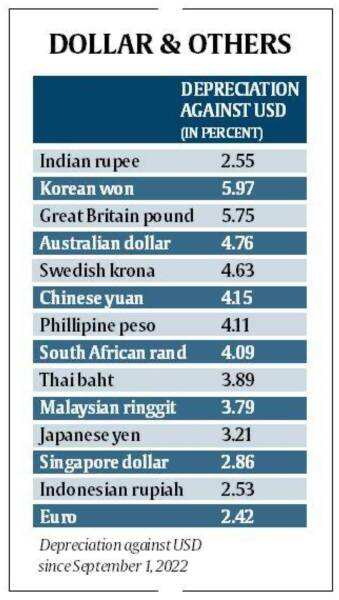Description

Disclaimer: Copyright infringement not intended.
Context
- Finance Minister Nirmala Sitharman last week remarked that the Indian Rupee hasn’t weakened but in reality, it is the US Dollar that has strengthened.
Must Read: Depreciation of Rupee: https://www.iasgyan.in/daily-current-affairs/currency-volatility-and-falling-rupee

What does it mean to strengthen the dollar?
- A strengthening U.S. dollar means that it now buys more of the other currency than it did before.
- A weakening U.S. dollar is the opposite—the U.S. dollar has fallen in value compared to the other currency—resulting in additional U.S dollars being exchanged for the stronger currency.
Demand for Dollar
- The demand for the dollar increases when international parties, such as foreign citizens, foreign central banks, or foreign financial institutions demand more dollars. Demand for the dollar is usually high as it is the world's reserve currency.
Current Scenario
- The dollar is at its highest level since 2000, having appreciated 22 percent against the yen, 13 percent against the Euro and 6 percent against emerging market currencies since the start of this year.
- While the US share in world merchandise exports has declined from 12 percent to 8 percent since 2000, the dollar’s share in world exports has held around 40 percent.
- Such a sharp strengthening of the dollar in a matter of months has sizable macroeconomic implications for almost all countries, given the dominance of the dollar in international trade and finance.
Why is the dollar strengthening?
- As of now, economic fundamentals are a major factor in the appreciation of the dollar:
- The decision by U.S. central bankers at the Federal Reserve to begin aggressively raising interest rates to fight inflation,
|
After beginning the year with a target interest rate of between 0% and 0.25%, the central bank has raised rates three times, into the range of 1.50% and 1.75%, with the promise of more increases to come.
With rates very low across the developed world, including in Europe where the European Central Bank has lagged behind in raising interest rates, the Fed's aggressive tightening is making it more attractive to hold dollar deposits in interest-bearing accounts in the U.S. That drives up the value of the dollar relative to that of other global currencies.
|
- A more favorable terms-of-trade—a measure of prices for a country’s exports relative to its imports—for the US.
- Global investors moving assets to the perceived safety of the U.S. in the face of uncertainty created by Russia's invasion of Ukraine.
- The massive terms-of-trade shock triggered by Russia’s invasion of Ukraine is a major driver behind the dollar’s strength. This is happening in Europe, in particular, because of the uncertainty created by the war in Ukraine. Russia, heavily sanctioned by the West for its aggression, controls much of the natural gas that Europe uses to power its factories and heat its homes. The surge in gas prices has brought its terms of trade to the lowest level in the history of the shared currency.
- At a very fundamental level, the US economy is doing better than other economies. Despite very high rates of inflation, the American job market has done extremely well and sectors like services have remained resilient. This has increased confidence in the market, and offset concerns such as those over a slowdown in the housing sector.
Effects in the US
- Within the U.S., the effects of a strong dollar are mixed. Americans traveling abroad will find that their money goes further than it used to — sometimes much further. A strong dollar also means that goods imported from countries whose currencies have dropped against the dollar become cheaper.
- At a time when high inflation is driving up prices, those lower import costs will offer relief to U.S. consumers. However, that relief will be limited. Though the dollar has gained against many other currencies this year, those gains have been smallest against the currencies of Canada, Mexico and China, the three largest U.S. trading partners.
- It's not good for American manufacturers or anybody who exports from here, because it makes their exports more expensive. That will add to the trade deficit, which is already enormous.
- So, policymakers have to pick a poison. Inflation or more trade deficits!
- Eventually USA’s Federal Bank will come under political pressure to lower rates in order to make U.S. goods more competitive on the global stage.
International impact
- A strong dollar can have a negative effect on the global economy in general, and on emerging market economies in particular.
- On the global level, a stronger dollar is associated with slower growth and international trade volumes. That's particularly harmful for open, emerging economies. It's associated with lower commodity prices, which hurts commodity exporters. It increases strain on poor indebted countries with loans denominated in dollars.
- A strong dollar can be particularly hard on poor countries, where it is correlated with declining demand and lower gross domestic product, as well as higher debt service costs. Increasingly, emerging markets are able to issue government debt in the local currency, but they still do borrow in foreign currency, and their businesses — those that are international-facing — have extensive dollar denominated debt. When the dollar rises, that tends to make all those debts more costly and generally inflicts a blow to financial conditions in the emerging market.
- For many countries fighting to bring down inflation, the weakening of their currencies relative to the dollar has made the fight harder.
- On average, the estimated pass-through of a 10 percent dollar appreciation into inflation is 1 percent. Such pressures are especially acute in emerging markets, reflecting their higher import dependency and greater share of dollar-invoiced imports compared with advanced economies.
- Several countries in the world like Turkey are facing double digit inflation.
Impact on Rupee
- Rupee touched another record low of 82.68. India's forex reserves stood at USD 532.87 billion in the week through October 7, in comparison to USD 642.45 billion a year back. The RBI in the past attributed the decline in the forex reserves to valuation changes arising from appreciating US dollar.
- India's Consumer Price Index (CPI) inflation in September rose to a five-month high of 7.41 percent. This is above RBI’s upper tolerance threshold of 6% of inflation. Figures remained well above the upper tolerance level of RBI's inflation targeting framework [i.e 6%] for the ninth consecutive month now.
- India's trade deficit widened to USD 25.71 billion in September as USD 61.51 billion of imports outpaced USD 25.71 billion of exports.
How Will Rupee Depreciation Impact Indian Economy
- Since India mostly depends on imports, including crude oil, metals, electronics semiconductors, etc. the country makes payments in US Dollars. Now if the Rupee is weak, it has to pay more for the same quantity of items. In such cases, the cost of raw materials and production goes up which gets passed on to the consumers in turn leads to spike in inflation.
- On the other hand, a weakening domestic currency boosts exports as shipments get more competitive and foreign buyers gain more purchasing power.
- The falling Rupee's biggest impact is on inflation, given India imports over 80 per cent of its crude oil requirement, which is the country's biggest import item.
- Indian students who are studying in the US will see their cost of studies going up at a time when inflation is at 40 year high in the US and prices of everything from cooking oil to petrol have skyrocketed.
Is the Indian rupee doing better than other currencies as Finance Minister mentioned
- Yes, it is. While the rupee lost 2.6% against the dollar in September, breaching the psychological marks of 81 and 82, it has been among the more stable currencies in the current environment that has impacted, in varying degrees, almost all currencies and economies.
- Therefore, the Korean won declined about 6 per cent against the dollar in September, and the British pound lost almost as much. The Australian dollar declined 4.8%, and the Swedish krona, Chinese yuan, and Philippine peso fell 4.6%, 4.1%, and 4.1% respectively.

Way Ahead
- The appropriate response is to allow the exchange rate to adjust, while using monetary policy to keep inflation close to its target.
- The higher price of imported goods will help bring about the necessary adjustment to the fundamental shocks as it reduces imports, which in turn helps with reducing the build-up of external debt.
- In this fragile environment, it is prudent to enhance resilience. Although emerging market central banks have stockpiled dollar reserves in recent years, reflecting lessons learned from earlier crises, these buffers are limited and should be used prudently.
- Countries must preserve vital foreign reserves to deal with potentially worse outflows and turmoil in the future.
- Fiscal policy should be used to support the most vulnerable without jeopardizing inflation goals.
https://indianexpress.com/article/explained/explained-economics/strengthening-dollar-weakening-rupee-numbers-8213007/















